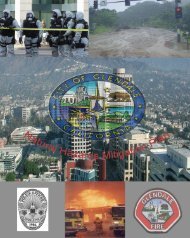Sayre Report - Hazard Mitigation Web Portal - State of California
Sayre Report - Hazard Mitigation Web Portal - State of California
Sayre Report - Hazard Mitigation Web Portal - State of California
You also want an ePaper? Increase the reach of your titles
YUMPU automatically turns print PDFs into web optimized ePapers that Google loves.
Wildlife Biology<br />
Habitats within the fire perimeter burned at predominantly low to moderate severity.<br />
Although areas <strong>of</strong> high severity were observed in most drainages, the broadest expanse<br />
<strong>of</strong> habitat that consistently burned with moderate severity occurred in the Elsmere<br />
Canyon area.<br />
Fires affect wildlife primarily through changes in habitat. Although individuals may have<br />
perished during the fire event, most wildlife populations should re-colonize the area as<br />
habitat recovers.<br />
Habitats impacted by frequent fires are at risk <strong>of</strong> type-conversion, which may reduce the<br />
possibility <strong>of</strong> full recovery to pre-fire habitat condition. Post fire sedimentation in riparian<br />
systems also poses a significant risk to sensitive wildlife species. Several species may<br />
be at risk from long-term displacement or extirpation.<br />
Treatments to Mitigate the Emergency<br />
o Implement appropriate BMPs upstream <strong>of</strong> sensitive riparian habitats to<br />
minimize sediment load.<br />
o Conduct post-fire surveys in riparian zones to detect and immediately<br />
eradicate non-native species (e.g. arundo).<br />
o Conduct post-fire surveys to assess wildlife populations and habitat<br />
recovery.<br />
o Conduct long-term monitoring <strong>of</strong> key species to document population<br />
trends.<br />
o Avoid livestock grazing in burned areas until at least the 2009-2010<br />
growing season.<br />
o Coordinate with local agency representatives prior to and during<br />
maintenance activities to avoid, minimize, and mitigate additional impacts<br />
to species, particularly along riparian zones.<br />
Treatment objectives are to protect rare plants and rare natural communities from<br />
human-caused disturbance, to promote native plant re-colonization <strong>of</strong> burned areas and<br />
dozer lines, to curtail invasive weed infestations in their incipient stages, and to avoid<br />
spreading invasive weeds into currently unoccupied areas.<br />
Botany<br />
Botanical values including rare plant species and natural communities were identified as<br />
being at-risk within the fire area. Rare plants and natural communities should recover<br />
from the fires naturally. Human activities post-fire present the greatest potential threat<br />
due to the potential for to damaging rare plants, inhibiting native plant regeneration,<br />
introducing invasive weeds, and type conversion <strong>of</strong> shrublands and oak woodlands to<br />
non-native annual grassland dominant systems due to increased fire frequency.

















